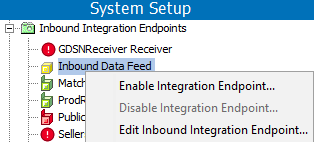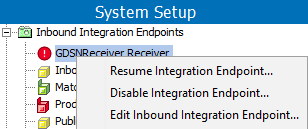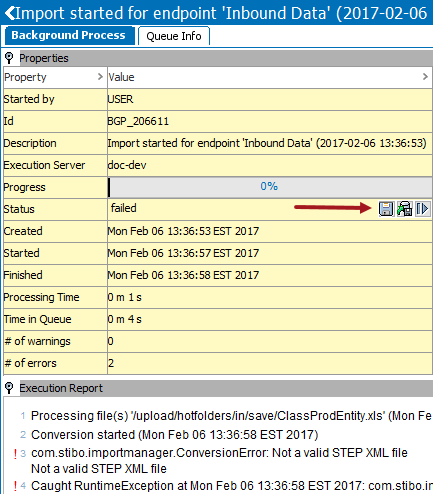Errors can cause an IIEP to go into a 'Failed' state (![]() ) or into a 'Failed (retrying)' state (
) or into a 'Failed (retrying)' state ( ), based on the type of error encountered and the settings on the Error Handling and Reporting step of the IIEP wizard.
), based on the type of error encountered and the settings on the Error Handling and Reporting step of the IIEP wizard.
For details on automatically handling connection errors which result in a 'Failed (retrying)' state ( ), refer to the IIEP - Error Handling & Reporting topic and the Running an Inbound Integration Endpoint topic.
), refer to the IIEP - Error Handling & Reporting topic and the Running an Inbound Integration Endpoint topic.
When an IIEP is in a Failed state (![]() ), you can reactivate it using Disable / Enable or Resume.
), you can reactivate it using Disable / Enable or Resume.
-
If a background process fails and the processing of data is set to strict, you must restart the endpoint before the endpoint is able to start another background process.
-
If a background process fails and the processing of data is set to chain, the remaining background processes that belongs to the chain will also fail. You must correct the failed background process before the endpoint is able to start another background process that belong to the same chain. The endpoint will, however, continue to process data from other chained background processes.
For more information about the strict and chain settings, refer to the Integration Endpoint Transactional Settings topic.
Disable and Enable a Background Process and Clear the Log
Setting an integration endpoint to Disable and then Enable the endpoint clears the log file.
-
Right-click the endpoint and select Disable Integration Endpoint.
-
Right-click the endpoint again and select Enable Integration Endpoint.

Resume a Background Process and Retain the Log
Resuming an integration endpoint does not clear the log file.
Note: Whenever the STEP system is patched or restarted, the main background process is automatically restarted. The integration endpoint log still exists, and continues to show an overview of the started background processes.
-
Right-click the endpoint and select Resume Integration Endpoint

Resolving a Failed Background Process
Errors can happen before the background process starts, and also after it is running. Error handling and reporting can be configured when creating an IIEP, as described in the IIEP - Error Handling & Reporting topic.
The levels of failure reported in STEP are errors and warnings.
-
Warnings are minor errors that do not stop the import. A warning status allows the process to complete and data validation to be performed elsewhere in STEP. For example, specifying a parent that does not exist, or an invalid value for a validated attribute.
-
Errors stop the import and prevent the endpoint from processing more data until it is restarted once the error is resolved. Errors are used in cases such as when a malformed XML, file is received, or when an endpoint expects XML but an Excel file is provided.
User friendly error logging is included on the Execution Report of the background process (accessible from the Background Processes tab of the IIEP), and more technical detailed logging is in the step.0.log (accessible from the system Start Page via the System Administration button).
IIEP Fails Before the BGP Starts
In cases where the IIEP fails before the BGP is initiated, a report is available in Integration Endpoint Log on the Inbound Integration Endpoint tab. Refer to this log for information to make needed corrections.

IIEP Fails After the BGP Starts
The Error Log Excerpts tab includes details about failures within the background process.
-
In System Setup select the relevant integration endpoint, and then click the Error Log Excerpts tab to display a list of failed background processes and the description of the failure.
You can also verify if a process has been suspended because it is dependent on a failed process.
-
In the Background Process column, hover over the background process to correct and click the BGP link.

The Background Process editor displays.

-
In the Background Process editor Execution Report, view the progress of the background process, and where it failed.
-
In the Properties area Value column, click the Save button (
 ) near the failed status and save the file locally.
) near the failed status and save the file locally. -
Open the file in a relevant editor and make the required changes.
-
After completing the changes, upload the file back to the same background process. In the Background Process editor on the Properties section, review the Status parameter Value column and click the Upload button (
 ) near the failed status.
) near the failed status. -
Restart the process in the Properties area via the Status parameter Value column. Click the Restart button (
 ) near to the failed status. The background process is restarted.
) near to the failed status. The background process is restarted. -
If the background process is part of a batch of chained processes, restart the other processes that are part of the chain.
Note: The Save (
 , Restart (
, Restart ( ), and Upload (
), and Upload ( ) buttons are available for selection in the Background Process editor under the following conditions:
) buttons are available for selection in the Background Process editor under the following conditions: -
The background process can be restarted.
-
The background process was completed with errors.
-
The background process is either a scheduled translation process, a scheduled Empty Recycle Bin process, or a scheduled profiling process.
-
The pre-processor for the background process has completed successfully and generated an XML file in the following directory:
Install.BackgroundProcessArea=///workarea/background-processarea/Inbound/
If none of these conditions are met, the buttons will not be displayed in the Value column of the editor.
-